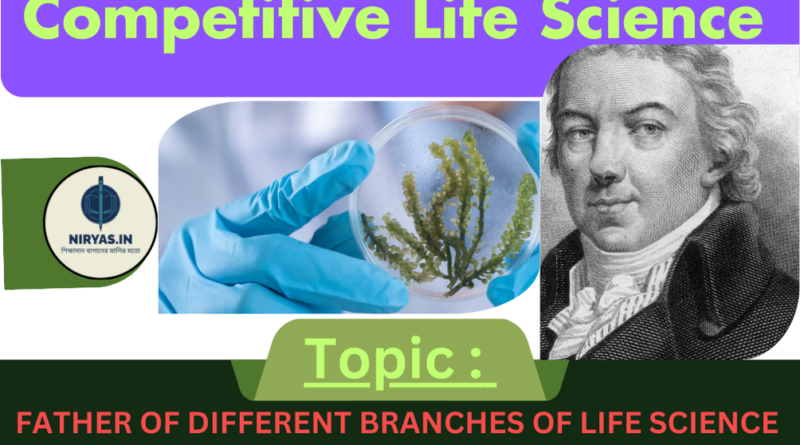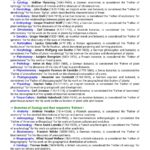Father of Life Science’s Different Branches
Father of Life Science’s Different Branches
Welcome to www.niryas.in . An important topic in competitive exam preparation is: Life Science. Questions in such exams come from various topics related to the Life Science. In this case, to help competitive students, we introduce the Competitive Life Science section. In this section, our main goal is to present to-the-point information from various topics related to the different topics of Life Science. In Competitive Life Science section some topics will be completed in several parts, so click Next to read the Next Part. Currently, in the post called Father of Life Science’s Different Branches, we have presented information on various branches of Life science and related their Respective “Fathers”. So, without waiting any longer, let’s take a look at the information ….
Father of Life Science’s Different Branches
➲ Definition : Life Science is a branch of science that deals with the study of living organisms, including their structure, function, growth, evolution, distribution, and taxonomy. It encompasses a wide range of disciplines, including botany, zoology, microbiology, biochemistry, molecular biology, genetics, ecology, evolutionary biology, neuroscience, and immunology.
➲ Characteristics of Fossils :
➦ Here are the 10 definitions of Life Science by prominent scientists :
1. According to Cannon, “Life science is the study of the chemical, physical, and biological processes that occur within living organisms, and the impact of these processes on the environment.” ⇨ Walter Cannon, “The Wisdom of the Body” (1932)
2. According to Lehninger, “Life science is the study of the structure, function, and behavior of living organisms, from the molecular to the ecosystem level.” ⇨ Albert Lehninger, “Biochemistry” (1949)
3. According to Jacob, “Life science is the study of the complex interactions between living organisms and their environment, and the impact of these interactions on the evolution of life.” ⇨ François Jacob, “The Logic of Life” (1973)
4. According to Sagan, “Life science is the study of the chemical, physical, and biological processes that occur within living organisms.” ⇨ Carl Sagan, “The Cosmic Connection” (1973)
5. According to Alberts, “Life science is the study of the evolution, development, and function of living organisms.” ⇨ Bruce Alberts, “Molecular Biology of the Cell” (1973)
6. According to Maturana, “Life science is the study of the complex systems and processes that govern the behavior of living organisms.” ⇨ Humberto Maturana, “Autopoiesis and Cognition” (1972) Father of Life Science’s
7. According to Dawkins, “Life science is the study of the interactions between living organisms and their environment, and the impact of these interactions on the evolution of life.” ⇨ Richard Dawkins, “The Selfish Gene” (1976)
8. According to Wolpert, “Life science is the study of the structure, function, and behavior of living organisms, from the molecular to the ecosystem level.” ⇨ Lewis Wolpert, “The Triumph of the Embryo” (1991)
9. According to Goodwin, “Life science is the study of the complex relationships between living organisms and their environment, and the impact of these relationships on the evolution of life.” ⇨ Brian Goodwin, “How the Leopard Changed Its Spots” (1994)
10. According to Wilson, “Life science is the study of the evolution, development, and function of living organisms, and the impact of these processes on the environment.” ⇨ E.O. Wilson, “The Diversity of Life” (1992)
➲ Subfields of Life Science :
1. Botany : Study of plants, including their structure, growth, evolution, classification, and distribution.
2. Zoology : Study of animals, including their structure, behavior, physiology, development, and evolution.
3. Microbiology : Study of microorganisms, including bacteria, viruses, fungi, and protists.
4. Biochemistry : Study of the chemical processes that occur within living organisms.
5. Molecular Biology : Study of the structure, function, and interactions of biological molecules.
6. Genetics : Study of heredity, genes, and variation.
7. Ecology : Study of the relationships between living organisms and their environment.
8. Evolutionary Biology : Study of the processes that have shaped the diversity of life on Earth. Father of Life Science’s
9. Neuroscience : Study of the structure and function of the nervous system.
10. Immunology : Study of the immune system and its responses to disease.
➲ Applications of Life Science :
11. Medicine : Development of new treatments and therapies for diseases.
12. Agriculture : Improvement of crop yields and development of new agricultural technologies.
13. Environmental Science : Understanding and mitigation of the impact of human activities on the environment.
14. Biotechnology : Development of new products and technologies using biological systems.
15. Forensic Science : Application of biological principles to aid in the investigation of crimes.
➲ Evaluational Timeline for Life Science :
✧ Ancient Greece : Aristotle and other Greek philosophers lay the foundation for the study of living organisms.
✧ 16th century : The discovery of the microscope by Antonie van Leeuwenhoek allows for the study of microorganisms.
✧ 17th century : The discovery of the cell by Robert Hooke lays the foundation for the study of cellular biology.
✧ 18th century : The discovery of the principles of inheritance by Gregor Mendel lays the foundation for the study of genetics.
✧ 19th century : The discovery of the theory of evolution by Charles Darwin revolutionizes the field of biology.
✧ 20th century : The discovery of the structure of DNA by James Watson and Francis Crick lays the foundation for the study of molecular biology.
✧ 21st century : The development of new technologies, such as genomics and gene editing, continues to advance the field of life science.
✧ 1950s : The discovery of the structure of proteins by Linus Pauling and the development of the first vaccines against polio and other diseases.
✧ 1960s : The discovery of the genetic code by Marshall Nirenberg and Heinrich Matthaei and the development of the first recombinant DNA technologies.
✧ 1970s : The discovery of the first oncogenes by Michael Bishop and Harold Varmus and the development of the first monoclonal antibodies.
✧ 1980s : The discovery of the first genes associated with human diseases, such as sickle cell anemia and cystic fibrosis, and the development of the first gene therapy techniques. Father of Life Science’s
✧ 1990s : The completion of the Human Genome Project and the development of the first genetically modified organisms (GMOs).
✧ 2000s : The discovery of the first microRNAs and the development of the first induced pluripotent stem cells (iPSCs).
✧ 2010s : The development of the first gene editing technologies, such as CRISPR-Cas9, and the discovery of the first genes associated with complex human diseases, such as Alzheimer’s disease and Parkinson’s disease.
✧ Present day : The continued development of new technologies, such as single-cell RNA sequencing and gene editing, and the application of these technologies to understand and treat human diseases.
➲ Branches of Life Science : Here are the main branches of Life Science :
✦ Biological Sciences :
❖ Botany : Study of plants, their structure, growth, evolution, classification, and distribution.
❖ Zoology : Study of animals, their structure, behavior, physiology, development, and evolution.
❖ Microbiology : Study of microorganisms, including bacteria, viruses, fungi, and protists.
✦ Interdisciplinary Sciences :
❖ Biochemistry : Study of the chemical processes that occur within living organisms.
❖ Biophysics : Study of the physical principles underlying biological processes.
❖ Molecular Biology : Study of the structure, function, and interactions of biological molecules.
❖ Genetics : Study of heredity, genes, and variation.
❖ Ecology : Study of the relationships between living organisms and their environment.
✦ Applied Sciences :
❖ Agriculture : Application of scientific principles to improve crop yields, disease resistance, and animal husbandry.
❖ Biotechnology : Use of biological systems, living organisms, or derivatives thereof, to develop new products and technologies.
❖ Environmental Science : Study of the natural world and the impact of human activity on the environment.
❖ Pharmacology : Study of the interactions between living organisms and chemicals, including the development of new medicines.
❖ Toxicology : Study of the adverse effects of chemicals on living organisms.
✦ Other Branches :
❖ Anthropology : Study of human beings, including their evolution, behavior, and culture.
❖ Bioinformatics : Application of computational tools and methods to analyze and interpret biological data.
❖ Biostatistics : Application of statistical principles to analyze and interpret biological data.
❖ Neuroscience : Study of the structure and function of the nervous system.
❖ Psychology : Study of the human mind and behavior.
💠 Branches of Life Science and Their Respective “Fathers” : Father of Life Science’s Different Branches
➲ Biological Sciences :
➱ Botany : Theophrastus (371-287 BCE), a Greek philosopher and student of Aristotle, is considered the “Father of botany”.
➱ Zoology : Aristotle (384-322 BCE), a Greek philosopher and scientist, is considered the “Father of zoology”.
➱ Microbiology : Louis Pasteur (1822-1895), a French chemist and microbiologist, is considered the “Father of microbiology”. Father of Life Science’s
➲ Interdisciplinary Sciences :
➱ Biochemistry : Friedrich Wöhler (1800-1882), a German chemist, is considered the “Father of biochemistry” for his discovery of urea synthesis.
➱ Biophysics : Wilhelm Conrad Röntgen (1845-1923), a German physicist, is considered the “Father of biophysics” for his discovery of X-rays.
➱ Molecular Biology : James Watson (1928-present) and Francis Crick (1916-2004), American and British biologists, respectively, are considered the “fathers of molecular biology” for their discovery of the structure of DNA.
➱ Genetics : Gregor Mendel (1822-1884), an Austrian monk and botanist, is considered the “Father of genetics” for his discovery of the laws of inheritance.
➱ Ecology : Ernst Haeckel (1834-1919), a German biologist, is considered the “Father of ecology” for coining the term “ecology”.
📥 Download Pdf : For Advanced Level Details
➲ Applied Sciences :
➱ Agriculture : Norman Borlaug (1914-2009), an American agronomist, is considered the “Father of modern agriculture” for his development of high-yielding crop varieties.
➱ Biotechnology : Herbert Boyer (1936-present) and Stanley Cohen (1922-present), American biologists, are considered the “fathers of biotechnology” for their development of recombinant DNA technology.
➱ Environmental Science : Rachel Carson (1907-1964), an American marine biologist, is considered the “mother of environmental science” for her book “Silent Spring”, which raised awareness about environmental pollution.
➱ Pharmacology : John Jacob Abel (1857-1938), an American pharmacologist, is considered the “Father of American pharmacology” for his discovery of adrenaline.
➱ Toxicology : Mathieu Orfila (1787-1853), a French physician and chemist, is considered the “Father of toxicology” for his work on the detection of poisons.
➲ Other Branches:
➱ Anthropology : Franz Boas (1858-1942), a German-American anthropologist who is considered the father of modern anthropology.
➱ Bioinformatics : Paulien Hogeweg (1943-present), a Dutch bioinformatician who is considered one of the founders of the field of bioinformatics.
➱ Biostatistics : Ronald Fisher (1890-1962), a British statistician and biologist who is considered the father of modern biostatistics. Father of Life Science’s
➱ Neuroscience : Santiago Ramóny Cajal (1852-1934), a Spanish neuroscientist who is considered the father of modern neuroscience.
➱ Psychology : Wilhelm Wundt (1832-1920), a German philosopher and physiologist who is considered the father of modern psychology.



